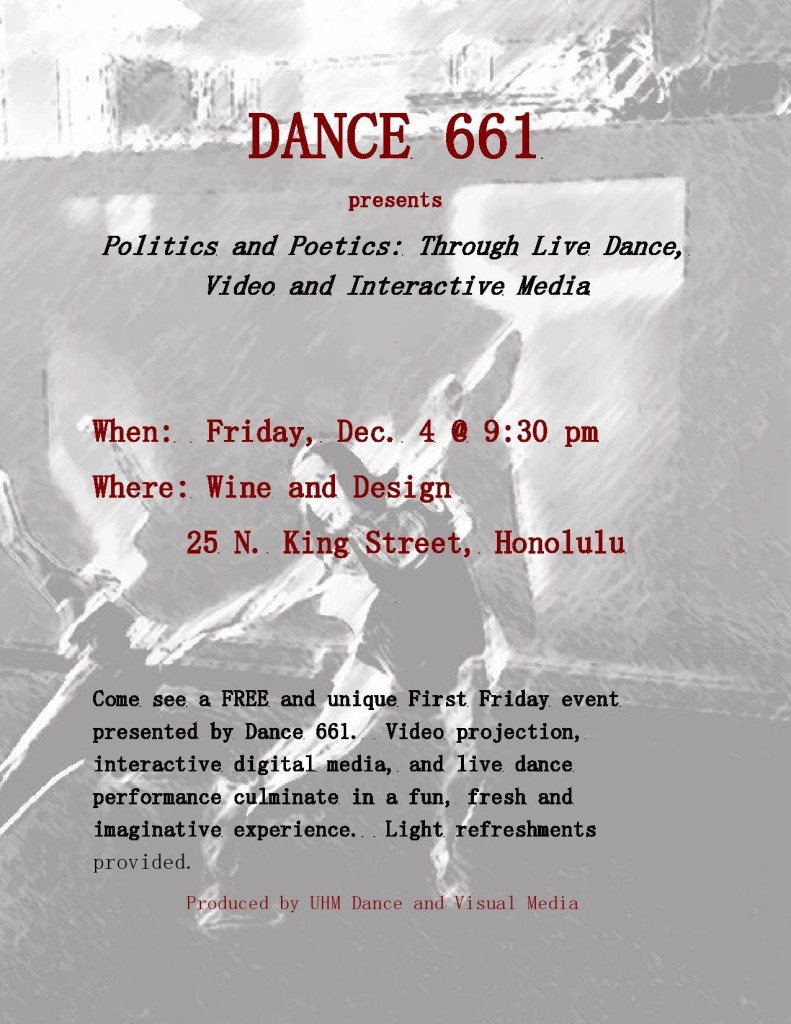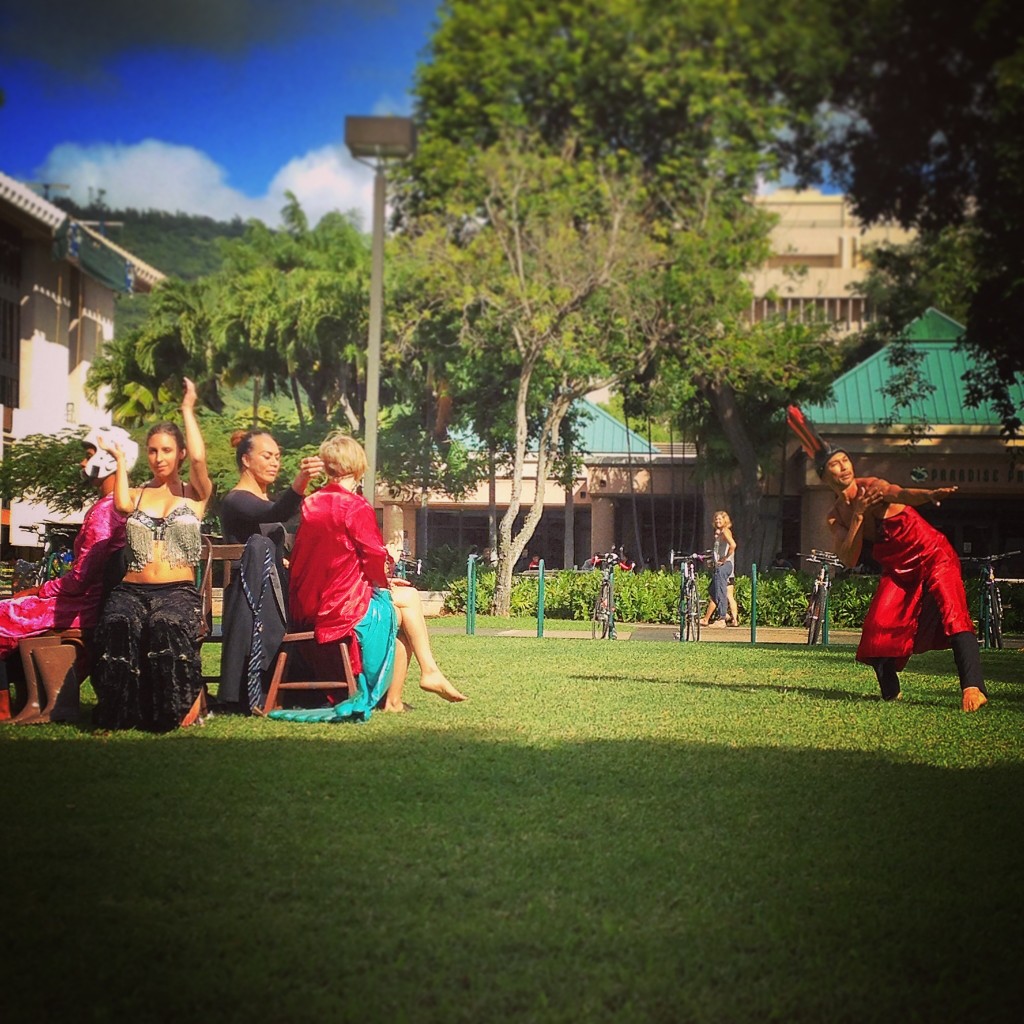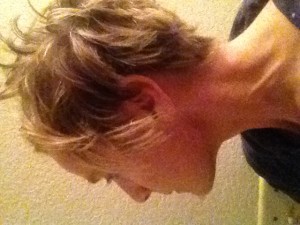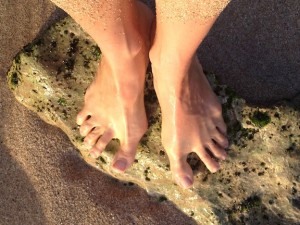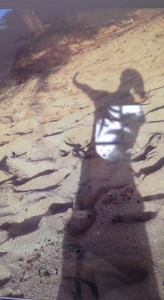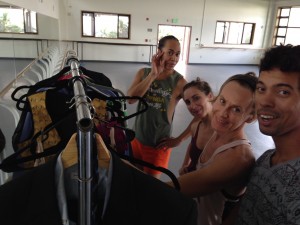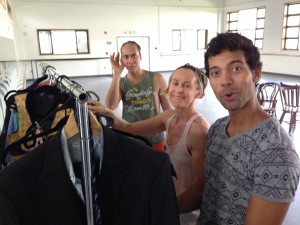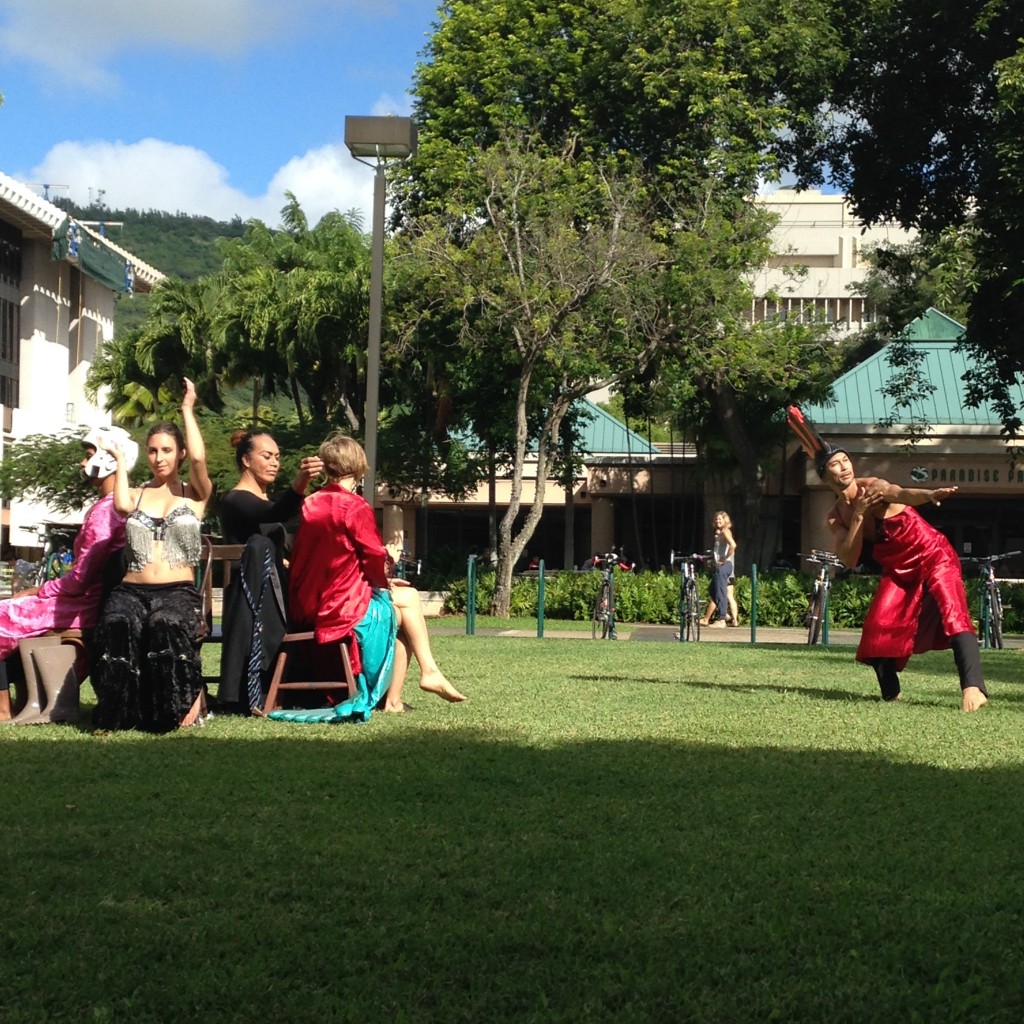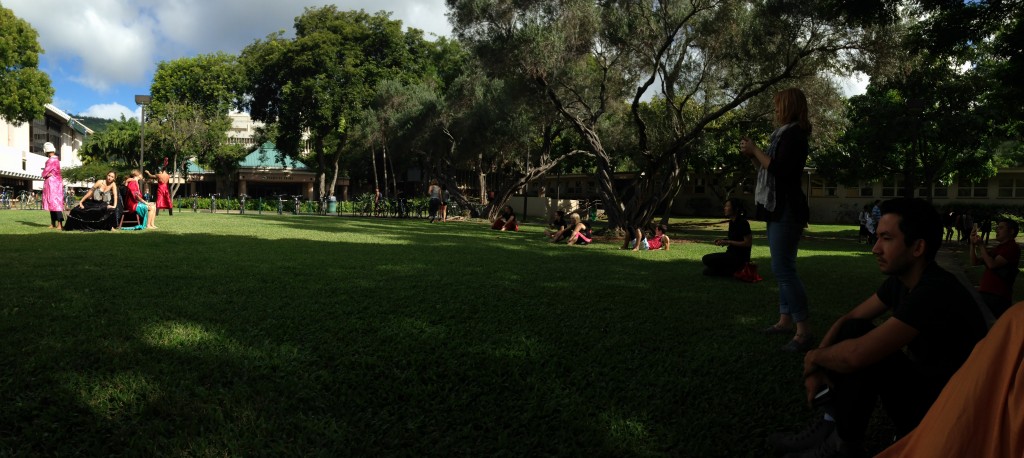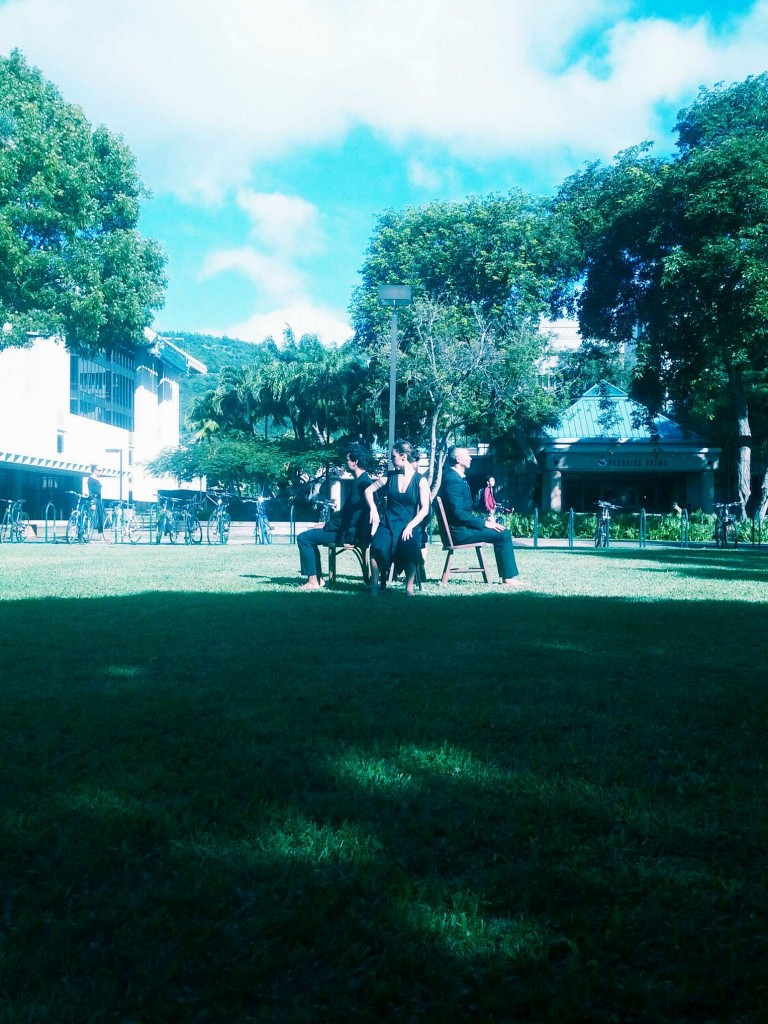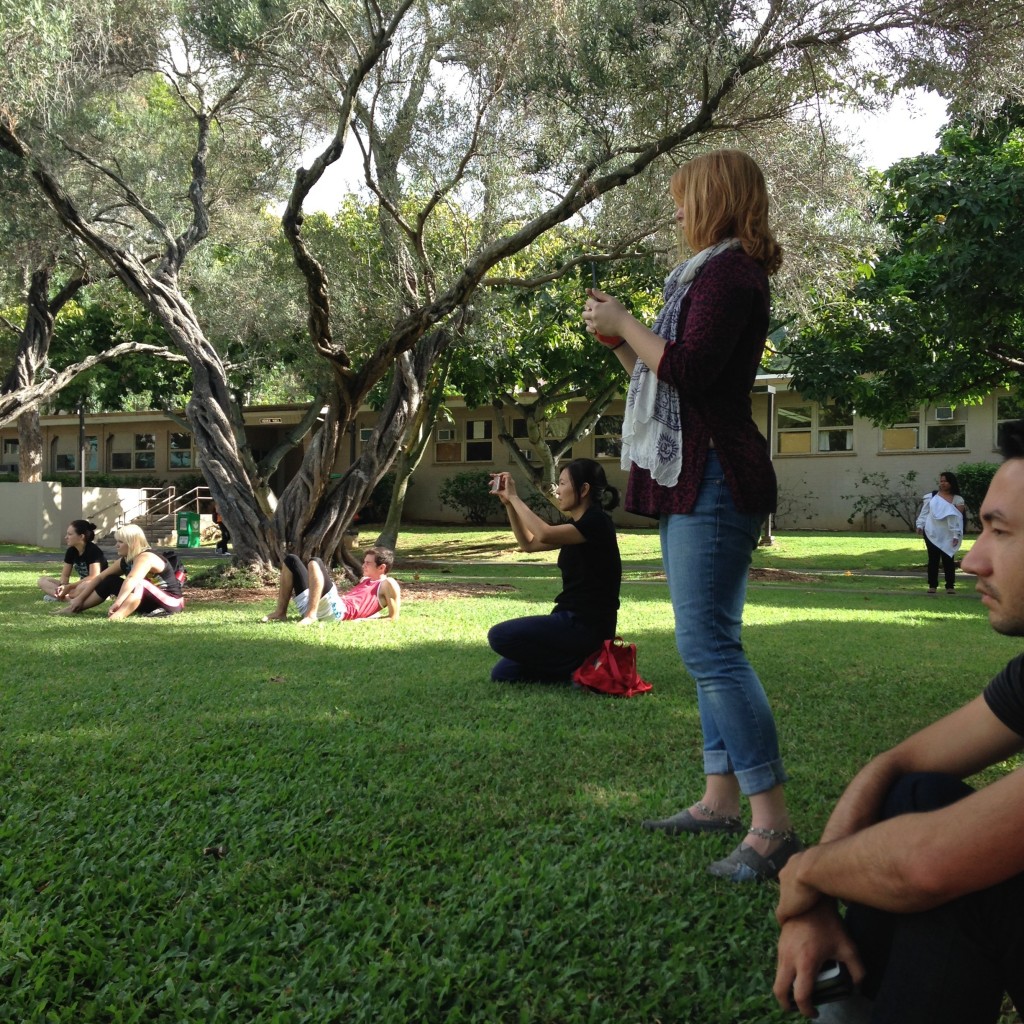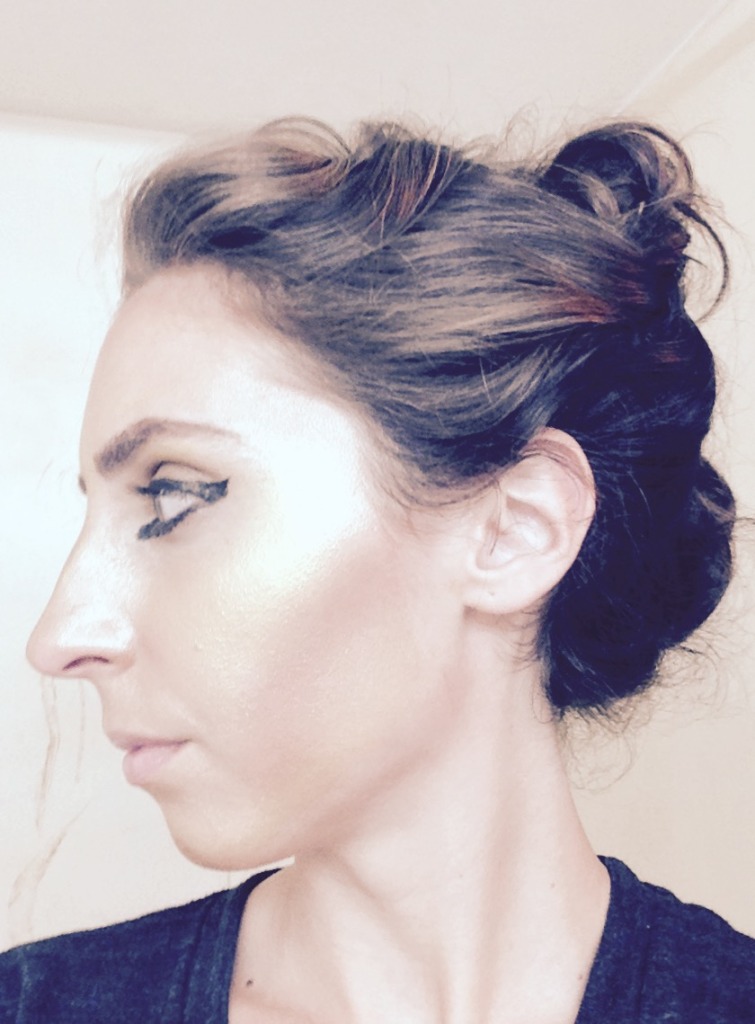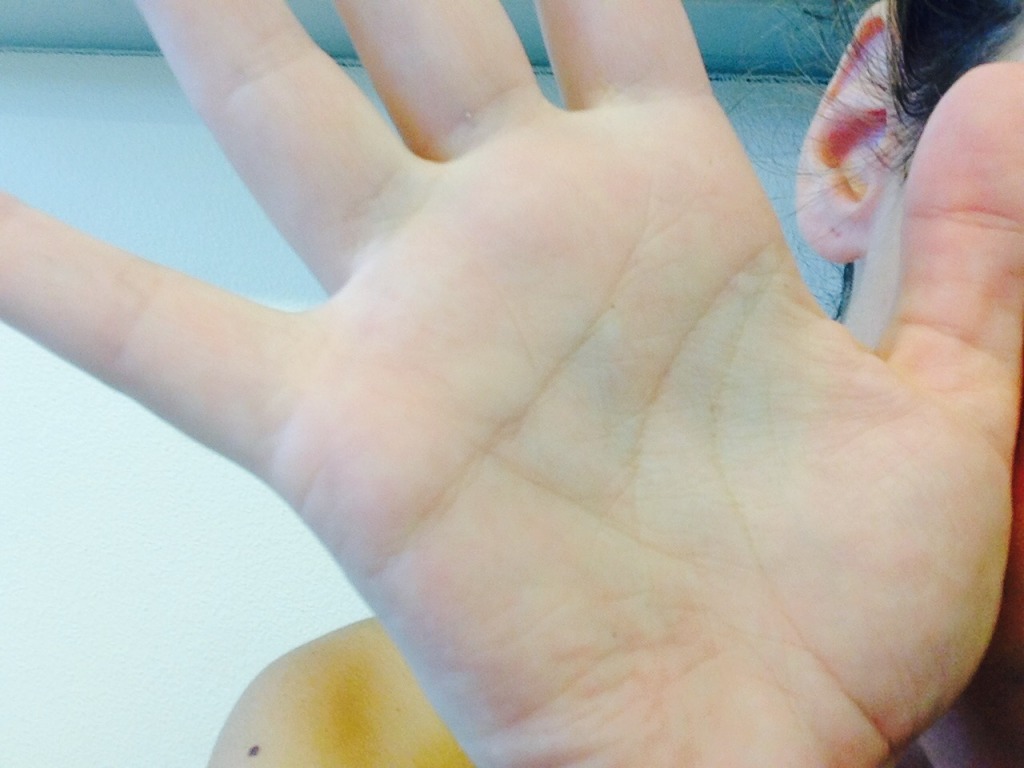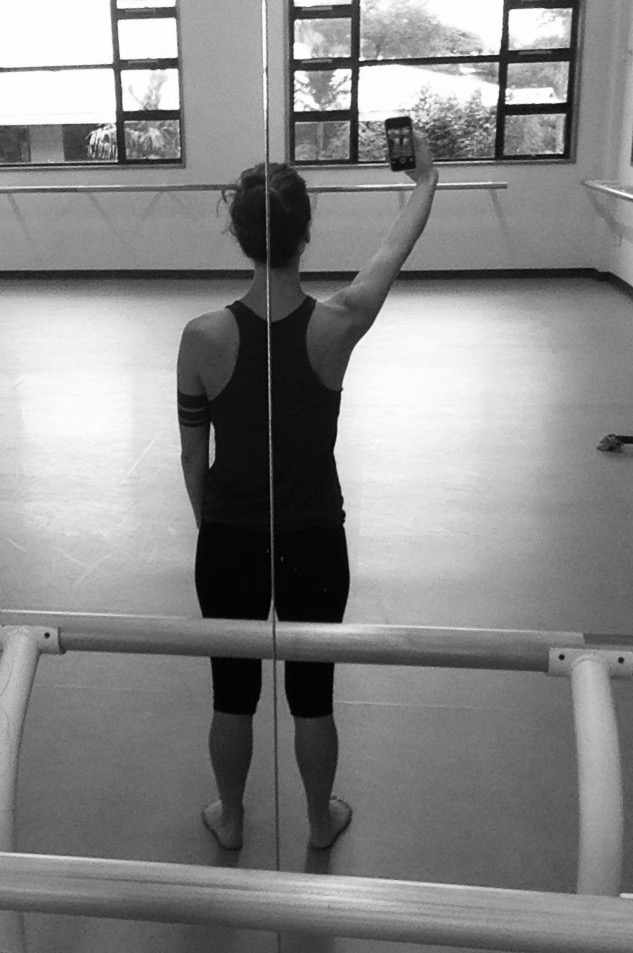This section is dedicated to sharing our different projects and processes in creating dance. With the use of journal writing, interview, pictures, video, we offer these ethnographic documents as tools for reflection and learning.
Sunday December 6, 2015
Graduate students of Dr. Kara Miller’s Dance and Technology class presented their final projects at WINE & Design as part of Chinatown’s popular art crawl called First Friday’s. Although it wasn’t completely packed at our event that night, it still felt like a nice community event and we were so grateful that Wine & Design so graciously gave us their space for our performance night called: Politics and Poetics: Through Live Dance,Video, and Interacvtive Media.
The performers converged at 8:30 pm to set up for our 9:30 pm start time. The entire hour was spent setting up the space by way of, clearing the tables, moving the art off the walls, and setting up the sound, projector, and computer. Also, we had a table for food and drinks. We began just shortly after 9:30 pm with 7 pieces for the evening. Mine was fourth in the order and I was very happy with how it turned out.
My dancers for this piece called Shelter were Camille Monson and Faith Im. They did a great job that night without having run through or rehearsal for it in this space. I really liked how the performance in this new space provideda really intimate setting. I also notice the contrast of their soft and glowing skin contrasted to the cold balck and white projected image of them on the screen. The video projection also looked crisp, vivid, and intriguing. I was very happy and also relieved that we had finished what we set out to do.
Afterwards, Kara told me that dance researcher and author Lynette Hunter was in the audience and had remarked on how she liked my piece. At first I really did not understand who she was, but Kara reminded me that in fact I had quoted her in one of my blogs and that she was a special guest lecturer this week at UH Manoa! Needless to say, this made me happy and validated my efforts and work to make dance and film come alive.
Below is a link to the video of the live performance of SHELTER and other stills documenting the process. SHELTER was filmed, edited, and choreographed by Wailana Simcock.
August 29, 2015
Reflection on “Dance and Interactivity” by Johannes Birringer
Mr. Birringer’s poignant article on the current state of dance and technology poses some interesting problems and ideas. He hit it on the nail for me when he states, “Such ‘movement-through’ interactive and generative environments posits a shift in perception that many dance practitioners, used to working in real time and real space, have been reluctant to engage”. I am happy if I can get enough money to get a camera to record my rehearsals, to purchase a video-editing program, to acquire lighting and sound for performances, and the basic technology and finances to costume, market, and develop my dances. It’s great to read about the technological advances like ‘MIDI-activated sonic environments’, VRML, and LCD projectors as part of the movement and convergence of dance with technology, it presently has little to do with me, or so it seems.
I feel that it is good to have the awareness and use of these new technologies as it pervades the dance world and experience, I am uncertain as to how to work with it. Out of the sheer lack of access to these amazing tools, I am at lost. Beyond knowing about these advances, how can it affect my dance-making? Where and how can I get the money to achieve the access to these technologies? Does my low-tech, old school, dance-making and performances irrelevant to the new world of cyberspace, projection, and ‘fusion of media’? Until I can master my video camera and editing program, I am not too worried about working with these new and amazing technologies until I actually engage with them – hopefully in the future. Until then, I will continue to be inspired by their magic and technological prowess via YouTube videos.
“Beyond the Eyes”
This work explores gender and the naked, natural body before it is clothed in the hegemony of social-political norms. This is also an act of research and discovery. The performance is intended to purposefully interrupt this norm by a free and public performance in a “guerilla – style” fashion scheduled for December 2, Tuesday, 9:30 am, in front of the Hamilton Library.
The hope of the performance is to allow a critical dialogue about the subject to occur. What do I take part in society? Why do I dress, talk, work, feel like I do? What does it mean to be a woman? A man? A mahu? Bisexuality?
This project wants to see beyond what the eyes see.
“Our seeing is already deeply predetermined. Much of the knowledge we gain through vision and our other senses, and the way we direct our seeing, is highly organized. To a large extent this is not a matter of choice but of our cultural and even our neural conditioning. We see conceptually, metaphorically, linguistically. But whatever our culture, we also see to some extent literally. There is always a tension between these two ways of seeing, and between our consciousness of meaning and being…Meaning shapes perception, but in the end perception can refigure meaning, so that at the next stage this may alter perception once again…”
– taken from Meaning and Being by David MacDougal
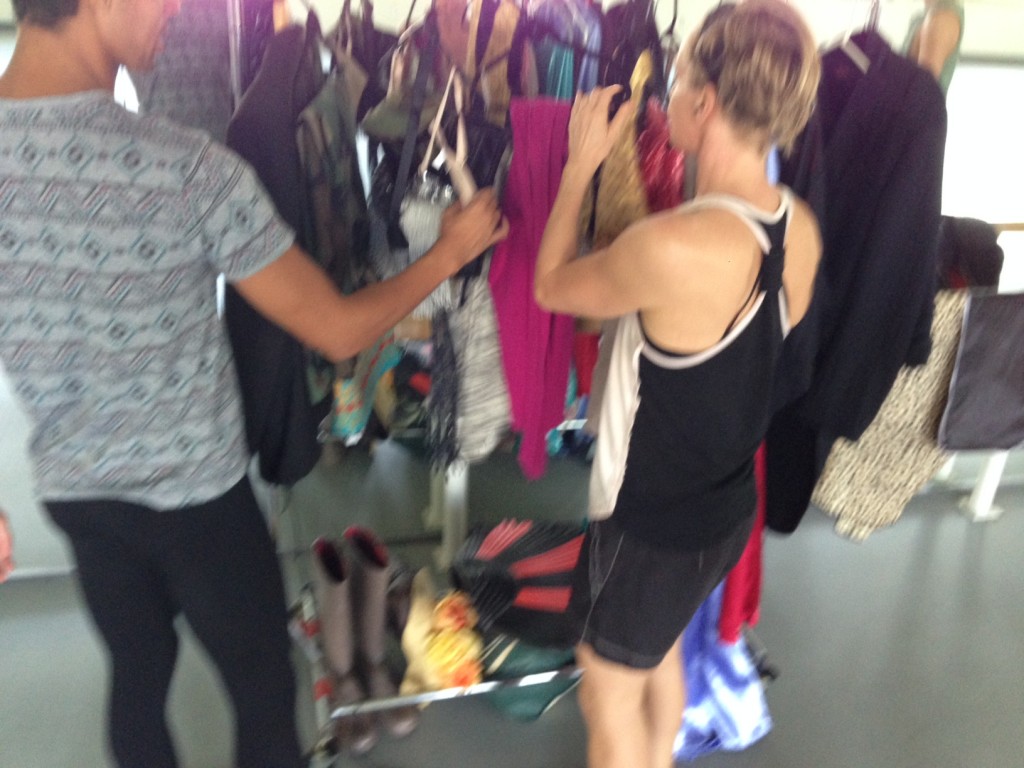 Yesterday was our first rehearsal. Sami couldn’t come at the last minute. Terry had to leave early, and Megan was late. Lucy was there the whole time. I first talked with all of them about why I wanted to do this piece. I wanted to actually do a piece directly related to the human body and the politics and perceptions about gender/sex and ultimately about the naked, natural body. We also talked about how place, history, and of course religion and politics have shaped the way we look at all this. I also shared with them about the risks of performing nude at my proposed site: the Lawn in front of Hamilton Library. I am encouraging nudity in this piece and not forcing anyone of them to do anything they didn’t want to do ( including wearing or not wearing a certain piece of clothing or clothes at all). Kara said she would be arrested with us, so that made us all feel better….
Yesterday was our first rehearsal. Sami couldn’t come at the last minute. Terry had to leave early, and Megan was late. Lucy was there the whole time. I first talked with all of them about why I wanted to do this piece. I wanted to actually do a piece directly related to the human body and the politics and perceptions about gender/sex and ultimately about the naked, natural body. We also talked about how place, history, and of course religion and politics have shaped the way we look at all this. I also shared with them about the risks of performing nude at my proposed site: the Lawn in front of Hamilton Library. I am encouraging nudity in this piece and not forcing anyone of them to do anything they didn’t want to do ( including wearing or not wearing a certain piece of clothing or clothes at all). Kara said she would be arrested with us, so that made us all feel better….
I have to go for now but check out these clips from rehearsal yesterday, mahalo, wai:
Feminine:
Masculine:
Section 1 Chair Choreo:
Section 2 Chair Choreo:
Beyond the Eyes – Dancers’ Interview : Listen to the dancers’ interview on the first day of rehearsal, November 15, 2014.
November 19, 2014
I asked the dancers if they would be willing to write a reflection about our process together creating this dance. I also encouraged them to take some pictures and/or video of themselves. Here is Lucy’s reflection and some pictures. Its a great read! Thanks Lucy….:)
LUCY
Gender / Sexuality / Nudity project reflections from 1st rehearsal 11/16/14
Super interesting. Enjoyed talking and listening and moving – all felt important. The biggest thing that came up for me was around the gestures “feminine” and “masculine.” I noticed an uncomfortable feeling in me. I noticed that that I came up with stereotpyes and I wondered why. I noticed that my “feminine” and “masculine” gestures had different common qualities – the “feminine” were coquettish, and they had an alertness and an energy of trying to attract, making my body into something to attract attention. I had a tension in my body. My “masculine” were more slouching, relaxed but also kind of self-consciously so, like I need to look like I’m making no effort to get anything or anyone – that’s part of the image. They were all like either cowboys or modern American men watching sports on TV. Today I’m curious why I enacted this, and a little stunned at what seems like evidence of my own colonization. How can I play as a performer with the tension engendered by extremes and polarities without enacting stereotypes in a way that doesn’t further any understanding? The gestures I performed had almost nothing to do with how I, or any woman I know, actually moves, except perhaps for the action of flicking hair out of our faces when it gets in the way. I realized later in the rehearsal that I associate my gestures with old Hollywood movies or drag performances. Which can be great, and are also different from my life. They’re also culturally Western, which is not surprising since I am too, but worth noticing. None of my gestures – feminine or masculine – had either any athleticism, or any real power.
I do know/ imagine that the piece will build in complexity from the juxtaposition of these gestures, not from one action alone. Today I tried a mothering gesture, holding an infant, and wondered why that didn’t come up as part of my movement repertoire yesterday? I think I was responding to a word – “feminine” – that is a cultural signifier that has increasingly little to do with how most women are in the world. Made me think about the evocative power of language – the difference between my response to “feminine gesture” and “masculine gesture” versus for example “gesture of female embodiment” and “gesture of male embodiment”
I just re-watched #likeagirl, the Always ad and I started to cry – it goes that deep for me, the enacting of, basically, lack of power and conviction, and how that gets painfully perpetuated. I know the intention of this piece is to provoke and question, and I wonder how I can / want to contribute to that?
During the rehearsal, I started thinking about third genders, and multiple genders, and the spaces in between, I think that was when I remembered the girls running and throwing in the #likeagirl ad, and that those actions don’t feel gendered, but human. If you’re running, it’s irrelevant whether you have a vagina or a penis. Just then Wai said he wanted extremes, and not some indeterminate middle ground. I feel a big part of my life and that of many friends of mine has been a search for that middle ground as a place of freedom from constraints. How to embody that in a way that still has performative tension and interest? I realized how tired I am of binaryness. Do polarities have to have only two poles? What about multiple poles that are still distinct and interesting. When I think about my ideals of beauty, strength and androgyny are central. If I break down my androgyny, exactly what makes it up? How much is in my daily movement, and how much in my hair and clothing choices?
I also noticed dancing in the chairs that I feel pressure from myself to perform what I think of as adequate femininity in the more “feminine” parts of this dance – which for me means grace, poise, pointed toes etc. Especially since I have a vagina, so I should be good at this shit. Why? I could “fail” at masculinity and be less hard on myself. But this is contingent. I know better intellectually than to conflate my biological sex with my capacities of gender expression, but I still do it. Especially in the dance world.
I also felt the part of me that just simply doesn’t like being looked at (a challenge in performance!) In the context of this class I now wonder – how much might this have to do with feeling my gender presentation somehow did not fit as I grew up? Just wanting to avoid the scrutiny?
The really interesting challenge for me here is that I clearly have to explore all this with my body. I have thousands of bits and words and memories of gender theories in my brain, but this challenge is different.
LUCY 11/19/14
Since I wrote that (above), I’ve been thinking more – mostly I have questions:
– Is this really just my own challenge to explore performing my (“feminine”)
– movements with more love and less internalized sexism? There are things I value about “femininity” after all – I just have to dig a bit deeper – the delicacy, care, the avoidance of brute force.
– or is this something to perhaps explore as a group, about the semantics – do other people have different reactions to “feminine” “womanly” “female” etc. “man” “manly” “masculine”– how are the word choices affecting the movement choices? Do some have negative connotations for some people, or memories of pressures to be this way and not be that way?
– Can we get to gender as a galaxy (my favorite image) starting from a binary? If not, how else? Can we / I be “male” in some part of my body and “female” in another at the same time?
– What are the actual subtle nuanced differences in everyday life – like pedestrian gendered movement as opposed to social gestures / movie tropes? The subtlety is actually more interesting to me than the exaggeration, but maybe more of a challenge in performance?
– When people chastise others for being a girlish boy or a boyish girl, what exactly are they perceiving – what movement quality cues them to notice / and often to judge and try to force back in line? (except in societies where third and fourth genders are recognized and valued)
– I realize I do somehow reference these poles (as in 2 poles, the binary I say I don’t like) in my body – as a bisexual person – I sometimes enact more femininity when I’m with a man or a more butch woman, and more masculinity with most women. Matter of fact vs. flirtatious? I have to watch more carefully. Matter of fact can be super sexy to me in a woman.
November 22, 2014
We had rehearsal today with the entire ensemble, Sami, Terry, Lucy, Megan, and myself. I unfortunately did not get any video this time around as I was so engrossed in the process of things! Ugh…But I have a couple of pictures. The good news is that we were able to go through the choreography, the music, and sequence of the performance. So not that the piece is “set”, I feel a little more accomplished and can “ease” into the rest of the work. The rehearsal itself went something like this: go over chair choreo, catch up Sami with content and purpose, then choose the sequence and problem solve some blocking, transitional phrases. Then we did an exercise that Marcus Quiniones shared with me about changing clothes with each other and standing in a line under self – chosen hierarchies. After the dancers exchanged clothes ( in a choreographed manner and in a a line) they would re-configure the line in accordance to their new donned clothes and in a different heirarchy – from low to high status. They chose where in the line they would stand. Later, we would take off clothes, but not put anything else on. Until some of us were naked. Actually three of us got completely nude, while two were left just in their undies! That was quite a successful venture. We all felt safe. But how will we do in public?
We were all talking about the hierarchy exercise and how it led us to start judging our selves and each other. We did it also very meticulously. I noticed how each one of us really took the time to see what we were wearing or not, and carefully placing ourselves in a proper order, low to high. Clothes both cover and reveal. They are full of symbols and reflect meaning back to the observer. Especially with out clothes or of the opposite clothes intended for you role, whether it be male or female, gay, bi, freak, etc. Clothes also cover and reveal the state of the human mind, its morals, belief systems, and the physical body itself. I hope that we can see beyond what the eyes sees, and see the social-political climates we engage in. – wai
December 1, 2014
It is the night before the performance. I’m naturally nervous – and excited! There’s seems to be a nice little buzz around it, people are saying they are gonna come. Actually, when I was creating this event and going over the performance in my head – I wanted to have the audience NOT know we were going to be there. Guerilla style. But of course, my friends want to know – they don’t count lol!
So, in lieu of a rehearsal on Saturday, I texted these words to the dancers:
Aloha gang – happy Sunday. I thought to send you the order of events for Beyond The Eyes this Tuesday. Prepare yourself by using it to “feel” and “know” the way the performance will / should / hopefully / open to changing in the moment – go, and imagine yourself there. The music assigned to sections aren’t rigid – the playlist is longer and can cover if we go over or use two songs for something…anyways, have a look:
9:30 am. meet at NDB and walk together with our costumes to site in front of Hamilton Library.
Show flow:
1. Sami solo/masculine chairs ( la vie enrose – piaf )
2. Person #2 solo chosen by Sami/ choreo chairs (walk on the wild side – reed)
3. Line up into Heirarchies (changes-bowie)
4. Terry #3 solo/ feminine chairs ( dress you up – madonna )
5. Person #4 solo chosen by Terry/ choreo chairs ( boy – book of love)
6. Person # 5 solo /masculine & feminine chairs (you are my sister – Antony)
7. Line up and take off (I want to break free – queen)
Pau
Mahalo nui loa for doing this. It means a lot to me. Excited xo
Waiwai
Well, that’s it for now – we’ll see what tomorrow brings. Me ke aloha, hiamoe pono, goodnight – wai
December 4, 2014
What a fantastic performance/event/experiment! The weather was perfect, the dancers really gave it their all, and there were no arrests! The security guard from the library gave us a quick look in the beginning and left us alone the rest of our 30 min. performance.
The biggest sensation I had after the show, besides being high for several hours after, was liberation. It was a very personal liberation – a sense of freedom and accomplishment as well. Like we really set out to do something and it got done the way I wanted it too – and in many ways, turned out even better. The one thing that could have been a lot better was the volume. It was way too low. The great news is that four out of the five of us got completely nude! That speaks a lot about how safe we felt and power and courage of the dancers. Which none of this could have happened without them. So a big mahalo to SAMI< LUCY< MEGAN< TERRY!! XO Laurie, thanks to you as well! Laurie so graciously volunteered to video our performance and is also editing it. Until I get the video to post, here are some pics of the actual show. mahalo, wailana
December 8, 2014
I just received this from Megan:
sat.15.nov: So many thoughts came up during this first rehearsal. One thought was that the setting and the cyclic nature of the piece remind me of Javanese theater and music. The second: Wailana asked us to be feminine, masculine, and to use movement to show male/female identities. It’s not that easy, though, because all the movement I thought of was stereotypical gendered movement. I feel this is closely linked with Wailana’s piece.The challenge for me is, how do we use the stereotype of gender roles to be the example of breaking stereotype? I feel like communicating the message to the audience could be tricky; what if we actually perpetuate stereotypes by using them? I’m excited to see the piece grow, I know that Wailana will take it in the right direction. He wants our movements to be clearly masculine or feminine, not ambiguous. How can I use stereotyped gendered movement, but convey a critique on it, challenge it? There’s the obvious dychotomy: be masculine in feminine clothes, and vice versa. Would it be possible to be clear in the opposite way? Can I be feminine, look feminine, and say within the movement something more? And the outrageous part–what would that be? Obviously there are lots of thoughts.
sat.22.nov: Wailana is planning on being naked at the end of the piece and is leaving it open for us to choose how we will be. Am I brave enough for that? Why don’t I want to be naked? Probably for the most simple reason: I’m not used to just being naked in front of strangers. I did dance around naked in a house with three girls once. One was a friend and the others I had met that night. We were just dancing and people started taking off clothes. Nothing sexual, just naked. I guess that was a situation where I felt free enough to go there, and even that was still a little intimidating. Gradual steps for me, I guess. I’m one of those people who get into cold water very gradually. Maybe Wailana likes to jump in 🙂
tue.2.dec: It’s the morning of the performance. Last night when I was going to bed I was thinking about what different things I wanted to wear during the performance! Hahahaaaaaa, pretty ironic. I wish I had a face mask of an old man or something. Oh well, next time.
And I also got this from Lucy today:
12/2 Performance
I prepared that morning differently having watched The Artist is Present. State of being. Taking my time. Cultivating.
Performance: I loved juxtaposing gestures and oddly matched costumes.
In line, pulling my bra over my head feels exhilarating. Pulling down my underwear even more so. Naked – liberation, standing firm on the ground, feeling the wind. Camaraderie and solidarity we built over the rehearsals helping us take the risks. Looking along our line, compared to the clothed hierarchies we’d played with, I suddenly see that collectively we have just redefined naked as powerful.
Second rehearsal reflections 11/25/14
Dress up – clothes as … power objects – how they change us, open up identities, parts of us we haven’t owned, shadows.
Just handed them – both choice from the rack and “here, put this on.” What does this do to you?
Physically walking in line, replacing myself, who am I, I keep changing, I think this dissolves a layer of ego, perhaps.
I needed to process all that about gestures in my last journaling, and then by the second rehearsal it seemed very simple and not conflicted – I just did my gestures with love, and added one maternal one. I did not mock, though mocking is rampant in the culture at large.
I enjoyed the contrast when we did “both”, mixed them up. I realized in my solo is where I can play with what I want to, including matter of fact / my interpretation of androgyny, depending on how I feel like that day. I also love wearing whatever I want and performing whatever genderness I want and the subversion of mixing those up. Not even subversion as I would have reveled in it in my 20s, a fuck you I’m more liberated than you kind of subversion that compares. But more- subversion as opening minds, my own included. About liberation from identities through playfulness.
This was powerful and fun.
Also my place in the first line, I knew as a mermaid I was a supernatural being, and so belonged “above” humans. Honoring spirit somehow, unseen worlds and legends. A sweet superhuman moment. Mermaids outrank men. Even though I know rank is a game and maya.
Watching “The Artist is Present”
notes I took:
Real knife & your own blood – performance. Ketchup – theater
Performance is all about state of mind. audience is like a dog, they can smell insecurity
Nude doorway; State of being; Wild, raw, vulnerable; Preparation, risk; Humanity of audience –enthralled – witnessing, relationship, silence, stillness, eyes, looking, being seen.
Beyond the Eyes is one of the performances that came out so fun and easy. Yet, hard and interesting. It kept you on your toes. I was practicing also the art of doing what was easy, fun, simple. Not to complicate matters. I was interested in having the dancers also experience a sense of ease in the creation and performance of it either. They really made this happen.
Below is a 6 min edit of the 30 min performance. Enjoy.
Video credit: Laurie Hubb
December 15, 2014
Beyond the Eyes
politics of gender, clothes, and the naked body
-practice as research
Our seeing is already deeply predetermined. Much of the knowledge we gain through vision and our other senses, and the way we direct our seeing, is highly organized. To a large extent this is not a matter of choice but of our cultural and even our neural conditioning. We see conceptually, metaphorically, linguistically. But whatever our culture, we also see to some extent literally. There is always a tension between these two ways of seeing, and between our consciousness of meaning and being…Meaning shapes perception, but in the end perception can refigure meaning, so that at the next stage this may alter perception once again…
–taken from Meaning and Being by David MacDougal
This passage from MacDougal sparked an interest in me to investigate how perception creates meaning in the way we look at gender roles, clothes, and the naked body. How and why do clothes make a man? A woman? How do people perceive others that do not fit in these categories? How about gestures? Depending on our gender, how and why is the way move and gesticulate perceived one way or the other? Why is it so important that we are even clothed at all? When is nudity appropriate, and who decides this? If meaning is created from a pre-condition, a condition given by society, then I wanted to create a performance that would help us to see beyond what the eyes physically see – and into the socio-political and moral climates that create their meaning.
I knew I wanted to explore the naked body as material for the performance. How do you do this in a performance without it looking cheap and contrite? Fortunately enough I came across the ‘grandmother of performance art’, Marina Ambramovic at the time of this research. “Abramović has used her body as both subject and medium of her performances to test her physical, mental, and emotional limits—often pushing beyond them and even risking her life—in a quest for heightened consciousness, transcendence, and self-transformation” (ART 21 Magazine). Inspired and awestruck by her work, she empowered me to trust my own feelings about exploring the naked body. I realized that this performance needed to be about disrupting the norm, pushing the limits, and taking a risk.
Blessed with four other dancers to take the risk with me, we made a beautiful performance in front of Hamilton Library. Four out of the five of us got completely naked. It was an exhilarating moment – a moment of liberation. It felt like I was my own person for those few minutes standing naked in the lawn on campus with a small and supportive audience. My own person free from the confines of society’s morals, free of the confines of clothes and gender roles. I felt empowered. This is who I am, my world, my body, my destiny.
Before we were able to get to this point of baring it all – we had to build trust. Influenced by the concept of ‘relational accountability’, I knew that this was the only way to work. In fact, it’s the only way to work with people no matter what the job is. Relational accountability “means that the methodology needs to be based in a community context (be relational) and has to demonstrate respect, reciprocity and responsibility (be accountable as it is put into action)” (Wilson). Prompted by this method, my first conversation with dancers was about explaining the piece: the different clothes to wear; the feminine and masculine gestures to work with; the hierarchy clothesline; the chair choreography; and the nudity aspect. I shared also that we only had two rehearsals to create it together. I was very explicit in letting them know they did not have to wear, put on, or take off anything that they didn’t want to. I was also clear about my intention of getting naked at the end of the performance and that they are welcomed to join.
Relational accountability allowed us to be mutually heard, respected, and honored. It made everyone feel like they were a part of the process and not just being told what to do. Nudity is a very loaded subject in our society and I know I had to approach this subject very delicately. I wanted us to all be there for each other, to support each other’s choices, and to not feel any pressure. These were our conditions and we stuck with them. Each of us were held accountable to each other in the process and during the performance. This process of relational accountability is something that I will always use and I mahalo Shawn Wilson for sharing it with all of us.
Another aspect of the process of this performance was auto-ethnography. I asked the dancers if they were willing to journal, take pictures, video, or any other means of documentation of themselves while creating Beyond the Eyes. There were no rules about what they chose to document or how, it just had to relate to the piece being made. Here is a poignant example of what one of the dancers, Lucy, wrote:
12/2 Performance
I prepared that morning differently having watched The Artist is Present. State of being. Taking my time. Cultivating.
Performance: I loved juxtaposing gestures and oddly matched costumes.
In line, pulling my bra over my head feels exhilarating. Pulling down my underwear even more so. Naked – liberation, standing firm on the ground, feeling the wind. Camaraderie and solidarity we built over the rehearsals helping us take the risks. Looking along our line, compared to the clothed hierarchies we’d played with, I suddenly see that collectively we have just redefined naked as powerful.
The power of dance, as reflected in this practice as research, is evident here in Lucy’s reflection. Dance is my practice, and if I or we, are able to journal and document the processes we undertake to create our art, the amount of insight and information there is invaluable. This topic of the naked and clothed body and the socio-political climates it must navigate through is ripe for the exploration of dance and movement. Practice as research opens an otherwise closed door to the viewers, the audience. These are like the “behind the scene” moments for the artist, but even better. Better because there are no smoke and mirrors, just honest reflections. This vantage point may never be seen otherwise to the viewer or the audience member. Practice as research is not only good for me, but for those who want to see what it was like making it, what we went through, and most importantly, how we felt about it.
-wailana

